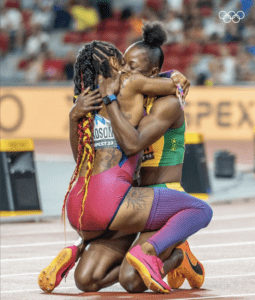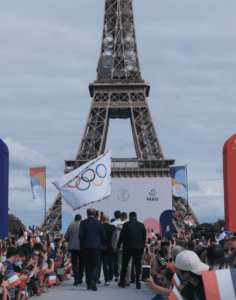Communication Strategy Is an Olympic Sport
Published on October 10, 2023, 8:58 a.m.
by Chloe Petro.
The Olympics, alongside the World Cup, is the largest sporting event in the world. The first recorded Olympic Games were in 776 B.C. and the first modern Olympic Games were held in Athens, Greece, on April 6, 1896.

From the very beginning, the Olympics has represented something bigger than sports. The “roots of the Olympic brand” have always “promoted peace, friendship and respect through sport.” Nothing compares to the impact of the Olympics; the world sets their differences aside to support the hard work and dedication of each Olympic athlete with the hopes of bringing home gold.
How does the Olympics communication team create a communication plan for an event of this caliber? The Games garner the most overwhelming and exciting audience: an international one. In an ever-changing world that is experiencing a shift in the way content is consumed, the communication team of the Olympics has figured out how to earn a gold medal from all their viewers.
The Olympic brand
The Olympic Brand Guidelines are the hub for everything one needs to know about what the Olympics represent. The extensive document produced by the International Olympic Committee highlights the Olympic brand, framework, characteristics, iconic symbol and much more.
The guidelines contain the vision statement of the brand, which is the focal point of everything its team creates for the Games: “Our vision is to build a better world through sport. To inspire, by being the best that we can be. The best of what we can achieve. Together.”
Additionally, the brand framework includes a purpose, vision, positioning and values that enforce its five brand characteristics: “hopeful,” “universal,” “inclusive,” “vibrant” and “progressive.” The Olympic symbol was strategically crafted as well. Each ring represents one of the five continents competing in the Games: “Africa, the Americas, Asia, Australia and Europe.” Each country’s flag is represented in the color of the rings.
As a PR practitioner, the key takeaway here is that every single part of a brand must be purposeful and integrated. From the brand characteristics to the meaning of the Olympic rings, everything relates back to the vision statement. The International Olympic Committee has carefully and pridefully crafted the Olympics brand so that its international audience is inspired live up to the gold medal standard. The next and most important step is properly disseminating this message to the world.
Communication strategy for gold
Janine Pollack, author of the “What The Olympics Has Taught Us About Marketing Strategy” noted, “The Olympics present a unique opportunity to reach a large percentage of audiences across age groups and demographics.” With the Olympics comes a multitude of challenges when communicating with millions of people.
Its communication team must know how people consume content nowadays, as well as what type of content they enjoy seeing. Additionally, they must choose specific anecdotes to share with the world that support the brand. These are strategies that public relations practitioners must be thinking about every day when communicating with their audiences.

Digital content focused on humanizing the athletes competing in the games has become the most effective way to reach these audiences. Erica D’Arcangelo-De Silva, CEO of Web Content Development and seasoned marketing professional, wrote “The Olympics Marketing Strategy,” which highlights just that.
In an interview with Platform Magazine, D’Arcangelo-De Silva said she was inspired to write the marketing strategy article because she sees the Olympics as a mega-marketing opportunity where there is room for endless content to be created. She explained, “The whole event should just be an opportunity to create content for brands, and every single athlete should be in partnership with some type of a brand.” She believes every athlete should have their own team of content creators.
Purposeful content
Specifically, the content being created must pull at the heart strings of viewers. D’Arcangelo-De Silva said the content needs to be “original, specific and curated to each person consuming it.” It also needs to highlight the stories and achievements of the individual athletes competing. Being able to connect with athletes as they share their experiences with us via social media helps tremendously with retaining an audience.
Jihoon (Jay) Kim, an assistant professor in the Department of Advertising and Public Relations at The University of Alabama, conducts extensive research in sports marketing and communication. As a former marketing staff member for the Korean basketball team Samsung Thunders, he has observed that Generation Z prefers consuming concise and meaningful content on social media.
He noted that when he worked on marketing projects with the Samsung Thunders, his primary responsibility was fostering a relationship with the media, journalists and public relations department. Now, the responsibility has shifted to taking care of the team’s and the individual athletes’ social media accounts because of Gen Z’s preferences.
Kim said Gen Z has lost interest in the Olympics because watching the Games on television is not conventional anymore. But, there is still hope. “The challenging point is that the popularity [of the Games] is not there anymore. But if [the Olympics communication team] revive their mission and rethink about our nation’s value through the Olympics, that interest will come back,” he explained.
Lessons for PR champions
Both D’Arcangelo-De Silva and Kim also emphasized that the Olympics hold a big social responsibility because of its large, international audience. D’Arcangelo-De Silva said, “Anyone who has a large audience has a responsibility.” Kim added that the Olympics must “unite all of the world” and “highlight human nature in this very moment,” given our nation’s climate.
The Olympics is the world’s largest stage and platform to send a message. As a public relations practitioner, that can be both a blessing and a curse. It is no longer enough for the games to be broadcast on live television. There must be a deeper connection between the athletes, the Olympics brand and the viewers.

The Olympics has taught us that a carefully crafted brand, as well as personalized digital content that draws a connection between athletes and the viewers, are the keys to success. Paris 2024 is just around the corner and should introduce more strategically curated content for all viewers alike.




